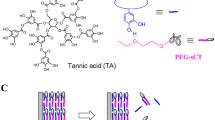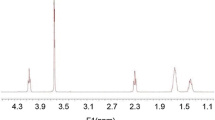Abstract
Purpose. To investigate the degradation of human calcitonin (hCT) by enzymes or mucosa from different gastrointestinal (GI) compartments and evaluate the stabilization effect of a synthetic ionizable copolymer on the stability of hCT in an aqueous solution. These data are a prerequisite for the development of a hydrogel based colon-specific hCT delivery system.
Methods. Luminal and brush border membrane (BBM) enzymes from the colon and small intestine (SI) of the rabbit were isolated and their enzymatic activity toward hCT in vitro was evaluated. Human fecalase was used to mimic the luminal enzymatic activity in the human colon and its degradation ability was assessed. Excised intact rabbit intestinal tissues from both the colon and the SI were used to study the degradation patterns of hCT by intact mucosa. Detection of intact human calcitonin was performed using gradient elution, reverse phase high-pressure liquid chromatography (RP-HPLC). The structure of the hCT fragments was determined by Matrix Assisted Laser Desorption/Ionization Time-of-Flight Mass Spectrometry (MALDI-TOF MS) analysis. UV/VIS and fluorescence spectroscopy methods were used to evaluate the influence of a copolymer, possessing the same structure as the primary chains in hydrogels degradable in the colon, on the fibrillation process of hCT.
Results. In vitro results showed that isolated luminal enzymes and BBM enzymes from the SI were more potent in degrading intact hCT, as expected. Moreover, BBM enzymes were far more abundant in the SI than in the colon. Compared with rabbit colonic luminal enzymes, the degradation potency of human fecalase was further abated. Intact mucosal studies revealed extensive degradation by the SI mucosa but not by the colonic mucosa. The primary structures of the peptide fragments were identified by MALDI-TOF MS analysis. Fibrillation studies of hCT indicated that acrylic acid-containing polymeric materials were able to decrease the aggregation of hCT in aqueous solutions.
Conclusions. Reduced proteolytic activity suggests that the colon is an advantageous site for peptide delivery. The structures of hCT degradation products were identified and the participation of particular enzymes in the degradation process was suggested. In addition, it was determined that an acrylic acid-containing copolymer improved the physical stability of hCT in aqueous solution.
Similar content being viewed by others
REFERENCES
M. Azria. The calcitonins. Karger, Basel. (1989).
J. Hastewell, S. Lunch, I. Williamson, R. Fox, and M. Mackay. Absorption of human calcitonin across the rat colon in vivo. Clin. Sci. 82:589-594 (1992).
M. Mackay. Delivery of recombinant peptide and protein drugs. Biotechnol. Genet. Eng. Rev. 8:251-278 (1991).
V. H. L. Lee and A. Yamamoto. Penetration and enzymatic barriers to peptide and protein absorption. Adv. Drug Del. Rev. 4:171-207 (1990).
J. P. F. Bai and G. L. Amidon. Structural specificity of mucosalcell transport and metabolism of peptide drugs: Implications for oral peptide drug delivery. Pharm. Res. 9:969-978 (1992).
P. Lagguth, V. Bohner, J. Heizmann, H. P. Merckle, S. Wolffram, G. L. Amidon, and S. Yamashita. The challenge of proteolytic enzymes in intestinal peptide delivery. J. Contr Rel. 46:39-57 (1997).
H. Brøndsted and J. Kopeček. Hydrogels for site-specific oral delivery. Synthesis and characterization. Biomaterials 12:584-592 (1991).
J. Kopeček P. Kopečková, H. Brøndsted, R. Rathi, B. Říhová, P.-Y. Yeh, and K. Ikesue. Polymers for colon-specific drug delivery. J. Contr Rel. 19:121-130 (1992).
P.-Y. Yeh, P. Kopečková, and J. Kopeček. Degradability of hydrogels containing azoaromatic crosslinks. Macromol. Chem. Phys. 196:2183-2202 (1995).
H. Ghandehari, P. Kopečková, and J. Kopeček. Biodegradable and pH sensitive hydrogels: Synthesis by a polymer-polymer reaction. Macromol. Chem. Phys. 197:965-980 (1996).
E. O. Akala, P. Kopečková, and J. Kopeček. Novel pH-sensitive hydrogels with adjustable swelling kinetics. Biomaterials 19: 1037-1047 (1998).
J. F. Woodley. Enzymatic barriers for GI peptide and protein delivery. Crit. Rev. Ther. Drug Carrier Syst. 11:61-95 (1994).
S. A. W. Gibson, C. McFarlan, S. Hay, and G. T. MacFarlane. Significance of microflora in proteolysis in the colon. Appl. Environ. Microb. 55:679-683 (1989).
T. Arvinte, A. Cudd, and A. F. Drake, The structure and mechanism of formation of human calcitonin fibrils. J. Biol.Chem. 268:5415-6422 (1993).
A. Cudd, T. Arvinte, R. E. Gaines Das, C. Chinni, and I. MacIntyre. Enhanced potency of human calcitonin when fibrillation is avoided. J. Pharm. Sci. 84:717-719 (1995).
M. Kessler, O. Acuto, C. Storelli, H. Murer, M. Muller, and G. Semenza. A modified procedure for the rapid preparation of efficiently transporting vesicles from small intestinal brush border membranes. Biochim. Biophys. Acta 506:136-154 (1978).
S. R. Lang, W. Staudenmann, P. James, H.-J. Manz, R. Kessler, B. Galli, H.-P. Moser, A. Rummelt, and H.-P. Merckle. Proteolysis of human calcitonin in excised nasal mucosa: Elucidation of the metabolic pathway by liquid secondary ionization mass spectrometry and matrix assisted laser desorption ionization mass spectrometry (MALDI), Pharm. Res. 13:1679-1685 (1996).
H. Tozaki, Y. Emi, E. Horisaka, T. Fujita, A. Yamamoto, and S. Muranishi. Degradation of insulin and calcitonin and their protection by various protease inhibitors in rat ceacal contents: Implications in peptide delivery to the colon. J. Pharm. Pharmacol. 49:164-168 (1997).
H. M. Ekrami, A. R. Kennedy, and W.-C. Shen. Water-soluble fatty acid derivatives as acylating agents for reversible lipidization of polypeptides. FEBS Letters 371:283-286 (1995).
M. Saffran, G. S. Kumar, C. Savariar, J. C. Burnham, F. Williams, and D. C. Neckers. A new approach to the oral administration of insulin and other peptide drugs. Science 233:1081-1084 (1986).
R. J. Mrsny. The colon as a site for drug delivery. J. Contr Rel. 22:15-34 (1992).
A. Serres, M. Baudyš, and S. W. Kim. Temperature and pH-sensitive polymers for human calcitonin delivery. Pharm. Res. 13:196-201 (1996).
M. Baudyš, D. Mix, and S. W. Kim. Stabilization and intestinal absorption of human calcitonin. J. Contr Rel. 39:145-151 (1996).
K. Ikesue, P. Kopečková, and J. Kopeček. Degradation of proteins by guinea pig intestinal enzymes. Int. J. Pharm. 95:171-179 (1993).
G. T. MacFarlane, J. H. Cummings, and C. Allison. Protein degradation by human intestinal bacteria. J. Gen. Microb. 132:1647-1656 (1986).
I. Schechter and A. Berger. On the size of the active site in proteases. I. Papain. Biochem. Biophys. Res. Commun. 27:157-162 (1967).
Z.-R. Lu, P. Kopečková, Z. Wu, and J. Kopeček. Functionalized semitelechelic poly[N-(2-hydroxypropyl)methacrylamide] for protein modification. Bioconjugate Chem., 9:793-804 (1998).
A. Bernkop-Schnürch. The use of inhibitory agents to overcome the enzymatic barrier to perorally administered therapeutic peptides and proteins. J. Contr Rel. 52:1-16 (1998).
R. Muff, M. A. Dambacher, and J. A. Fischer. Formation of neutralizing antibodies during intranasal synthetic salmon calcitonin treatment of postmenopausal osteoporosis. Osteoporosis Int. 1:72-75 (1991).
H. Nakamuta, R. C. Orlowski, and R. M. Epand. Evidence for calcitonin receptor heterogeneity: binding studies with nonhelical analogs. Endocrinology 127:163-169 (1990).
Author information
Authors and Affiliations
Corresponding author
Rights and permissions
About this article
Cite this article
Lu, R.H., Kopečková, P. & Kopeček, J. Degradation and Aggregation of Human Calcitonin In Vitro. Pharm Res 16, 359–367 (1999). https://doi.org/10.1023/A:1018813416523
Issue Date:
DOI: https://doi.org/10.1023/A:1018813416523




